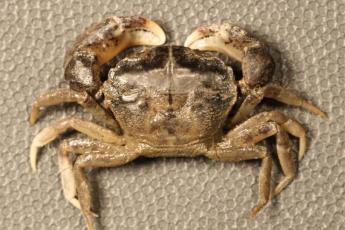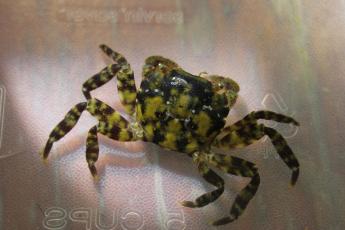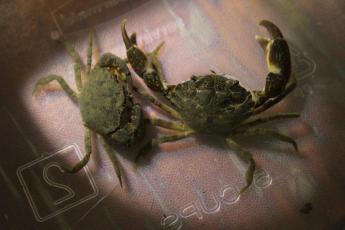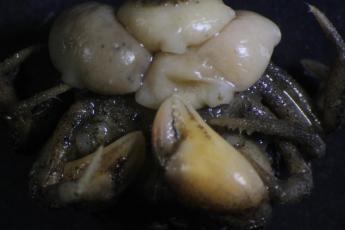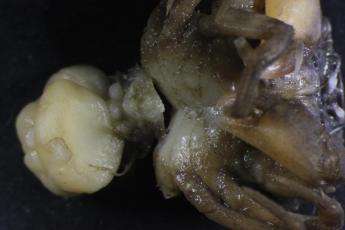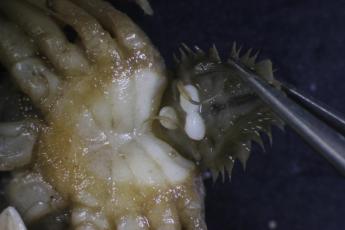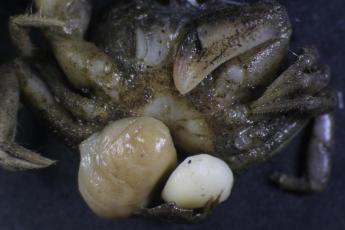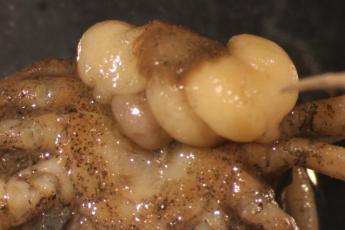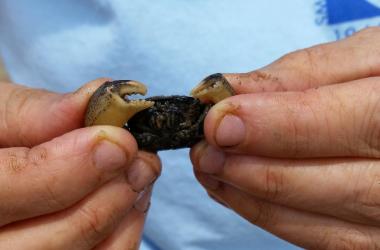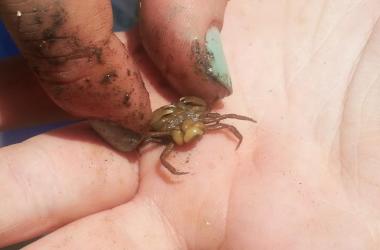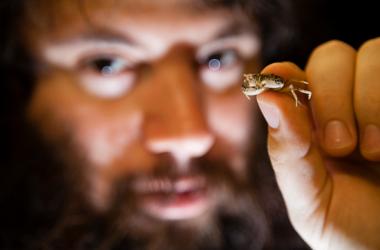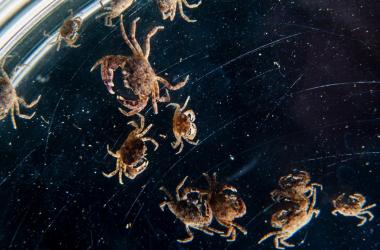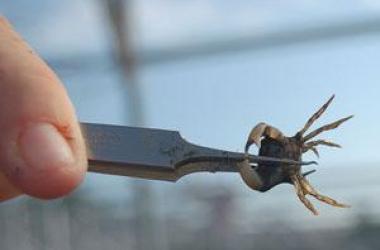Research ProjectMud Crabs and Body-Snatching Parasites
The Chesapeake Bay Mud Crab Parasite Loxothylacus panopaei
Affiliated Labs
Project Goal
To evaluate the long-term interactions between host and parasite including adaptation and resistance throughout the entire range of the mud crabs. The hosts are two species of mud Crab (Rhithropanopeus harrisii and Eurypanopeus depressus), the parasite is Loxothylacus panopaei.
Description

The white-fingered mud crab (Rhithropanopeus harrisii) is probably the most abundant crab in Maryland waters of the Chesapeake Bay. These crabs are small in size (< 1 inch across) and occur in shallow waters --- scampering around oysters, fallen logs and woody debris, and under docks and other submerged structures. It is not unusual to find 50-100 of these crabs on a single log or a grab of oyster shells!
The Marine Invasions Lab has been studying mud crab populations in Maryland since the 1990s, to understand what controls their abundance and distribution. One aspect of our research focuses on the parasitic barnacle Loxothylacus panopaei (Loxo), which infects mud crabs. Loxo is a recent arrival and was introduced to Chesapeake Bay in the 1960s from the US Gulf of Mexico. Our research explores the effects of Loxo on mud crabs and how this changes through time. As part of this research, we routinely measure Loxo prevalence throughout Maryland, including sites on the Eastern Shore, southern Maryland, and central Maryland near the Smithsonian Environmental Research Center (SERC).
For our research, we regularly survey crabs using “crab condos”, which are simply small plastic crates filled with dead oyster shells. Crab condos provide attractive habitat, which mud crabs colonize quickly. Every June and August, we survey two-month-old condos to measure mud crab and Loxo populations. These surveys have revealed large fluctuations in crab and Loxo population size. Additional laboratory experiments underway by our team suggest that temperature and salinity play an important in population dynamics and also that some crabs are resistant to infection.
Contact
Monaca Noble, noblem@si.edu, 443-482-2467
The Making of a Zombie

The introduced parasite, Loxo, is turning native mud crabs in Chesapeake Bay into zombie nursemaids. Tiny female Loxo larvae use a dart-shaped injection stylet to inject embryonic cells into the crabs. These cells grow into a mature parasite that wraps around the crab’s nervous system. The parasite assumes complete control over the host crab, controlling major functions such as molting and reproduction as well as compromising the crab’s immune system and eliminating the crab’s ability to reproduce.
When the parasite is ready to reproduce it produces a large sac, called a virgin externa, which protrudes through the crab’s abdomen. Male parasites are attracted to the virgin externa. When they locate the opening in the externa they use their stylet to inject trichogon cells. These cells develop into two testis that fertilize eggs within the sac (externa). Once the parasite has grown its testis, full reproduction is triggered. The sac, now a mature externa, triples in size to hold thousands of larvae. Under the right conditions Loxo can produce a new brood of larvae every five or six days!
Who takes care of all these parasite larvae? The zombie nursemaid does. The infected crab tends to the sac of the parasite like a female crab looks after her eggs. But since the parasite targets both genders, male crabs also mother the larval parasites.
To trick the male crabs into tending to her young, the parasite feminizes the male crabs. She does this by changing his behavior and giving him a wide apron, just like a female crab. Having a wider apron helps him hold the huge sac protruding through his abdomen. Most infected crabs have only a single sac to support, but some have several. If a crab has multiple sacs, it usually has two or three, but six sacs on a single crab have been reported. Do multiple sacs mean multiple parasites? While genetic analysis has only been done with a few crabs, early results point to multiple parasites rather than multiple sacs from a single parasite. For the crab, this might be like multiple puppeteers fighting for control over a single puppet.
Publications
Blakeslee, A.M. H., Pochtar, D.L., Fowler, A.E., Moore, C.S., Lee, T.S., Barnard, R.B., Swanson, K.M., Lukas, L.C., Ruocchio, M., Torchin, M.E., Miller, A. W., Ruiz, G.M. and Tepolt, C.K. 2021. Invasion of the body snatchers: the role of parasite introduction in host distribution and response to salinity in invaded estuaries. Proceedings of the Royal Society B-Biological Sciences, 288 (1953) https://doi.org/10.1098/rspb.2021.0703
Tobias, Z.J.C., A.E. Fowler, A.M.H. Blakeslee, J.A. Darling, M.E. Torchin, A.W. Miller, G.M. Ruiz and C.K. Tepolt. 2021. Invasion history shapes host transcriptomic response to a body-snatching parasite. Molecular ecology, https://doi.org/10.1111/mec.16038
Fowler, Amy E., Forsstrom, Tiia, von Numers, Mikael and Vesakoski, Outi. 2013. The North American mud crab Rhithropanopeus harrisii (Gould, 1841) in newly colonized Northern Baltic Sea: distribution and ecology. Aquatic Invasions, 8(1): 89-96. doi:10.3391/ai.2013.8.1.10
Freeman, Aaren S., Blakeslee, April M. H. and Fowler, Amy E. 2013. Northward expansion of the rhizocephalan Loxothylacus panopaei (Gissler, 1884) in the northwest Atlantic. Aquatic Invasions, 8(3): 347-353. doi:10.3391/ai.2013.8.3.11
Grosholz, Edwin D. and Ruiz, Gregory M. 1995. Does spatial heterogeneity and genetic variation in populations of the xanthid crab Rhithropanopeus harrisii (Gould) influence the prevalence of an introduced parasitic castrator? Journal of Experimental Marine Biology and Ecology, 187: 129-145.
Alvarez, Fernando, Hines, Anson H. and Reaka-Kudla, Marjorie L. 1995. Effects of parasitism by the barnacle Loxothylacus panopaei (Gissler) (Cirripedia: Rhizocephala) on growth and survival of the host crab Rhithropanopeus harrisii (Gould) (Brachyura: Xanthidae). Journal of Experimental Marine Biology and Ecology, 192: 221-232.
Newsletters
December, 2019 - The Chesapeake Bay Parasite Project
December 10, 2018 - Tracking Zombie Crabs, The Chesapeake Bay Parasite Project
November 16, 2017 - Tracking Zombie Crabs, The Chesapeake Bay Parasite Project
October 21, 2016 - In Search of Zombie Crabs The Chesapeake Bay Parasite Project
History of the Project
An introduced parasite from the Gulf Coast is affecting native mud crabs in Chesapeake Bay. The parasite Loxothylacus panopaei (Loxo for short) infects and assumes control over the host crab, controlling major functions such as molting and reproduction as well as compromising the crab’s immune system. This process eliminates the crab’s ability to reproduce and results in the crab caring for the developing larvae of the parasite. The host effectively became the parasite's zombie nursemaid.
SERC researchers having been studying the prevalence of Loxo in populations of the White-fingered Mud Crab, R. harrisii, since the 1990s in hopes of understanding how this introduced parasite affects the mud crab population. Dr Gregory Ruiz (SERC) and Dr. Mark Torchin of the Smithsonian Tropical Research Institute (STRI) begun collection mud crabs in 2003 with ten sites in distributed throughout Maryland's Chesapeake Bay. These ten sites were surveyed every summer through 2015. At each site crabs were collected in habitat collectors, which are small plastic crates filled with dead oyster shells that sit on the surface of the sediment. These crates stayed in the water for two months, during which time mud crabs took up residence between the oyster shells. After two months, each crate was pulled up and the crabs were hand-collected from the oyster shell habitat. These crabs were then measured, sexed, and examined for outward signs of the Loxo parasite in the laboratory.
In 2012 Dr. Amy Fowler, a SERC postdoctoral fellow, examined data collected since 2003 and found that the Loxo parasite is very abundant some years and but nearly absent in others. This trend was probably influenced by environmental factors, most likely salinity and temperature. To further investigate this, Dr. Fowler conducted targeted experiments to determine why the population was fluctuating. These experiments looked at the possible impact of temperature and salinity on the physiology of the various stages of both host and parasite, both independently and together. Additional lab and genomic studies were conduced in 2015 by Dr. Carolyn Tepolt, a SERC post-doctoral fellow, to answer evolutionary questions such as have crabs in Loxo's native range adapted more resistance to infection than crabs in Loxo's introduced range. To do this Dr. Tepolt infected crabs from the Gulf Coast (Loxo's native range), sites in the southeast (Loxo's introduced range), and sites in New England where Loxo is absent.
In 2013 the survey transitioned to a participatory science initiative, Chesapeake Bay Parasite Project, which allowed us to expand the scope of the project and address questions that we were unable to address in the 2003-2013 dataset. If you would like to get involved sign-up here.
Learn more about the project in this Ecosystems on the Edge is a mini-video series covering some of SERC's key research areas including climate change, watersheds, invasive species, at risk species, and more.
Gallery
